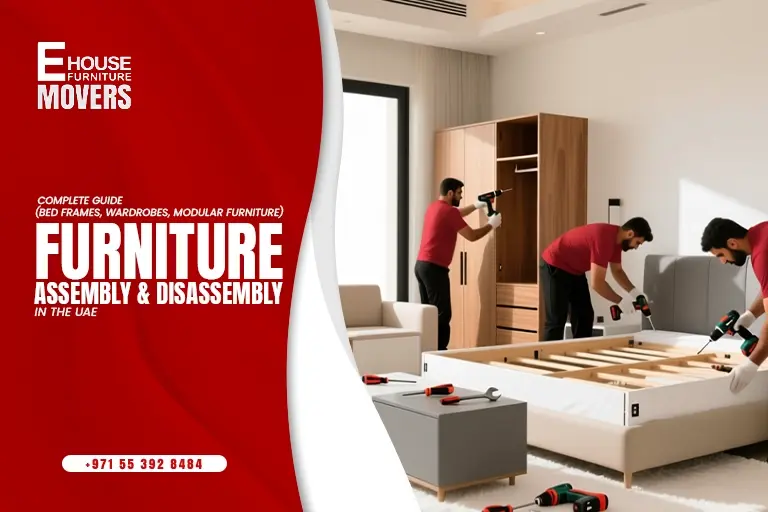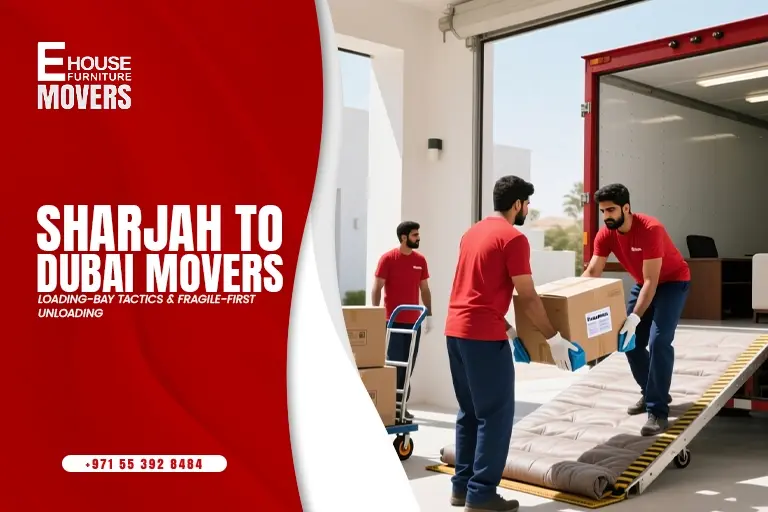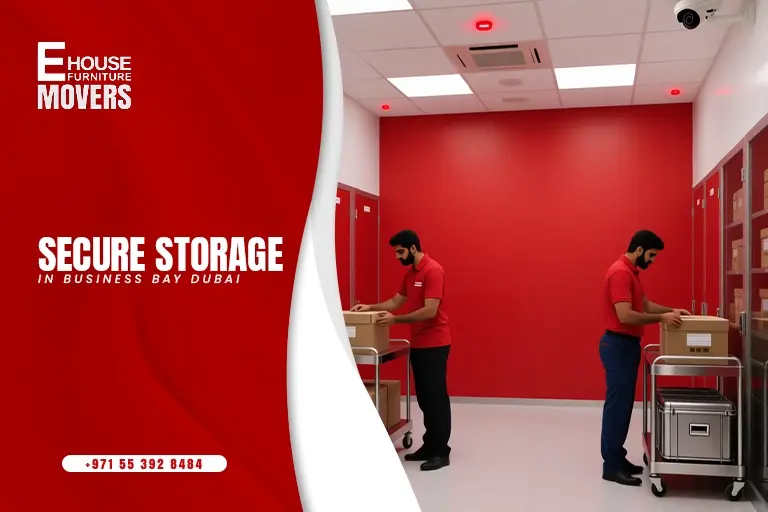Furniture assembly & disassembly is the process of systematically dismantling large furniture items, preparing them for transport, then rebuilding them at the destination.
In the UAE context, this typically applies to homes, offices or hospitality units where furniture must be moved through lifts, stairwells or narrow corridors. For example, moving a 3-door wardrobe or king-size bed often requires disassembly to pass through a service elevator or door frame.Professional Furniture Movers in the UAE often include disassembly and assembly of bed frames, wardrobes, and modular furniture to ensure safe transit.
This service is frequently offered by moving companies in Dubai and Abu Dhabi to enable relocation of bulky items with minimal damage and efficient access.
Also Read: Best Furniture Movers in UAE: Services, Costs, and Regulations
Which furniture typically needs disassembly before moving in the UAE?
Large or awkward-shaped items commonly requiring disassembly include bed frames, wardrobes, modular or built-in units, glass-front display cabinets, and office workstations.
- Bed frames: King, queen or rarely twin sizes often include side rails > 2 m, making lift access difficult without removal of rails or slats.
- Wardrobes: 2-door or 3-door wardrobes — especially sliding-door types — may exceed width/height limits or cannot navigate curved hallways.
- Modular furniture: Flat-pack or custom modules from brands or contractors that span walls/floors.
- Glass or showcase cabinets: Fragile components require dismantling of glass or removal of fixed panels.
- Office workstations: Integrated desks, partitions or cable trays may be framed in and need disassembly for relocation.
In UAE service-lists you’ll find these listed separately (flat-pack vs bespoke; disassembly vs re-assembly).
How much does furniture assembly/disassembly cost in the UAE?
Typical market ranges in the UAE: around AED 75–129 per hour per technician for standard items; or AED 150–250 per unit for simple pieces. Costs for furniture assembly in Dubai may vary slightly depending on the district and building rules. Local Furniture Movers in Dubai can provide accurate quotes including elevator bookings and permits.
- Online marketplaces list flat-rate hourly technician fees around AED 75/h for basic habits and up to AED 129/h for more experienced crews.
- Example: A simple wardrobe or bed might be itemised at AED 150–250 for dismantle + re-assemble (excluding transport).
Cost drivers include:
- The number of items (volume)
- Complexity: sliding doors, mirrored surfaces, built-in units
- Access challenges: stairs, narrow doorways, high floors
- Materials: glass, heavy hardwood, custom metal framing
- Location: Dubai vs Sharjah vs Abu Dhabi may differ in labour/access costs
- Quotation transparency matters: ensure disassembly, packing, transport and re-assembly are all defined.
Why use professional assembly rather than DIY?
Using a professional assembly/disassembly service reduces risk of damage, injury and delays compared to DIY.
- Manual handling research shows high incidence of musculoskeletal disorders (MSDs) in material-handling tasks: A study of 535 employees across 33 employers found ergonomic interventions lowered physical demands and MSD risk.
- For furniture moves in the UAE professionals bring correct tools, experience navigating access (e.g., service elevators, NOC procedures) and protective packing to mitigate damage to property or furniture.
- Example: Without proper disassembly, a wardrobe moved intact might scratch walls or get stuck, causing extra time and cost.
Thus, hiring a trained crew is often more efficient and safer than DIY in high-rise or regulated environments.
What UAE building rules affect assembly/disassembly on move day?
Building rules in Dubai/Abu Dhabi commonly require Move-In/Move-Out permits (NOC), service elevator booking, truck parking permissions and scheduling outside peak hours.
- For instance, in the Emaar communities the NOC fee may range AED 500-1,000, and permit validity is typically 7–14 days.
- The portal for application often requires: tenancy contract or ownership proof, Emirates ID or passport copy, utility clearances, moving company licence/insurance.
- High-rise buildings: moving trucks must often use designated loading bays, elevators are booked in timeslots, and noise or lobby protection rules apply. Community managers may reject un-booked moves.
Practical implications:
- Submit your NOC and elevator booking at least 3–5 business days ahead of the move.
- Confirm with building management: truck access routes, parking permit, lobby protection (floor/door guards)
- Failure to comply may cause delays or extra charges.
What is the standard UAE assembly/disassembly process?
The typical process is: site survey, dismantling & labelling, packing & protection, transport, re-assembly, alignment & functionality check, hand-over.
Details:
- Pre-move survey: The technician inspects furniture item types, access points (door widths, lifts), staircases, load-limits, building logistics.
- Dismantling & labelling: Hardware (screws, bolts) is bagged with labels; panels are marked; photographs can help reglue them together.
- Packing and protection: Items covered with blankets/foam; edge-guarded glass panels; labeled parts put together.
- Transport: Truck protective padding by the Crew; load strapping; climate-sensitive handling of delicate materials (wood, upholstery).
- Assemble at destination location: Panel location, frame assemble, sliding doors positioned, anti tip kit (wardrobes/ tall units), make sure load bearing components are properly torqued.
- Last check and delivery: The technician ensures that all doors/drawers are working, furniture is flat and all debris cleared, client signs.
This is a well-organized workflow that prevents the loss of components, improper assembling or injuries during shipping/on-site.
What tools and materials do assembly technicians use?
Technicians in the furniture assembly/disassembly that work in the UAE use: torque limited drivers, metric/imperial bit sets, hex keys, soft-mallets, panel lifters, felt pads, corner guards, anti-tip units and protective packages.
Rationale:
- Torque limited motors avoid excess tightening that may strip threads or smash panels..
- Large boards (e.g., wardrobe sides) can be manipulated safely with the help of panel lifters.
- Soft-mallets and felt pads guard finished surfaces from damage during assembly.
- Anti-tip kits ensure tall furniture meets safety brackets (especially important in UAE high-rise units).
- Packaging materials: thick moving blankets, moving straps, bubble wrap, edge protectors, cardboard slip-sheets—especially for glass or high-gloss surfaces susceptible to scratching or expansion in UAE temperature/humidity.
Using appropriate tools and materials ensures efficiency, safety and prevents damage or warranty claims.
How do flat-pack and modular systems change the job?
Flat-pack and modular furniture alter the assembly/disassembly scope by increasing fastener count, requiring precise alignment and often using pre-manufactured connectors — they require less dismantling but more re-assembly precision.
Comparison:
- Flat-pack units (e.g., from global or local build-to-order systems) arrive in panels with factory-pre-drilled holes; faster to assemble but still require accurate alignment of sliding doors, hinges, cam locks.
- Modular/bespoke systems (wall-to-wall wardrobes, built-in entertainment units) often require custom panel removal, rewiring of LED or fitted components, incorporation of plumbing/electrical if designed for it, more structural load-assessment and anchoring.
Impact on cost and time:
- Flat-pack: lower cost per unit, often listed as “per piece” charge.
- Modular: quoted separately, more labour hours, may require special tools or additional crew for heavy panels or anchored units.
In Dubai/Abu Dhabi, many providers explicitly list flat-pack vs custom modular as separate service lines.
Hence clients should clarify whether their furniture is flat-pack or custom when receiving quotes.
How do warranties and brand policies interact with third-party assembly?
Brand warranties typically remain valid if the assembly/disassembly follows manufacturer instructions; third-party services are acceptable, but documentation (manuals, invoices) should be retained to support claims.
Key considerations:
- Most brands of furniture (local and international) must be properly installed (leveling, anchoring, required fasteners) in order to be warranted.
- In contracting a third-party service in the UAE, make sure that the technician is operating on the hardware/fasteners provided by the manufacturer, as this could cancel the warranty.
- Store assembly documentation, installation pictures, and hardware baggage as evidence in the event of warranty claims.
- Make clear, warranty on transport and assembly damage in transit of moving – not all brand warranties apply to movement after initial installation.
In this way, ensure you read the warranty of your furniture and inform your assembly/disassembly company about your expectations.
What building-access mistakes delay furniture setups in Dubai/Abu Dhabi?
The common delays are due to the inability to obtain Move-In/Out permits (NOCs), neglect of the planning of elevator bookings, the mis-planning of parking/truck access, and last-minute scheduling.
Examples of mistakes:
- Late submissions of NOC; 3-5 business days lead time is the norm in certain societies.
- Attempting to bring a huge wardrobe with you using the elevator in the main lobby rather than booking the elevator in the service, and being turned away.
- Other vehicles parked in the truck parking leading to additional manpower/time to move the items.
- Breaking of building regulations on protective floor/door covers resulting in access restriction or extra payment.
- Booking a move at the peak hours without authorization leading to delays or fines.
Mitigation tips:
- Move-in/out process of confirming building, elevator booking window, availability of truck bay.
- Make sure that company is acceptable in the eyes of the management of the community as not every estate allows any mover.
- Pre-movings are done to document and photograph site conditions to prevent disputes.
What safety practices minimize damage and injuries during assembly?
Adhering to ergonomic principles, team-lifting, and structured workflow significantly reduces injuries and furniture-damage risk.
Supporting evidence:
- A study on furniture assembly workstations found that adjustment of workstation height and training reduced physical strain and musculoskeletal complaints. ResearchGate+1
- Another ergonomic review emphasised that effective interventions lowered the incidence of musculoskeletal disorders in manual material handling.
Best practices for UAE moves:
- Use team lifts for heavy/bulky items; avoid twisting while carrying.
- Keep load < 15 kg per person when feasible; when heavier, use lifting aids or crew.
- Secure floor coverings in loading/unloading areas to prevent slips.
- Wrap and pad panels carefully to prevent corner damage or scrapes in high-rise walls.
- Use anti-tip bracing on wardrobes/tall units to meet safety standards and minimise risk of toppling in apartment settings.
These practices protect both workers and furniture, reducing future claims and repairs.
What should a UAE quote include for assembly/disassembly?
A comprehensive quote should itemise scope, labour basis, packing/protection materials, access constraints, insurance or liability cover, permit/booking handling, and post-assembly checks.
Checklist of quote items:
- Scope of work: List each piece (e.g., “King-size bed frame: disassembly, transport, re-assembly”), include destination floor, stair vs elevator.
- Labour basis: Hourly rate vs per-unit. Specify number of technicians and estimated hours.
- Materials & protection: Include packing blankets, straps, hardware bags, disposal of old furniture if required.
- Access constraints: Note if stairs, narrow corridors, elevator booking, truck bay timing apply; include any additional charges.
- Permit handling: Indicate if the moving company will manage the building’s Move-In/Out permit (NOC) and elevator booking or if client is responsible.
- Insurance/liability: Provide details of damage cover or crew liability for furniture and property.
- Final QA/hand-over: Confirm that alignment checks, door/drawer function, and cleanup are included.
By comparing quotes on these criteria, clients in the UAE can assess provider quality, risk of hidden costs and ensure proper service delivery.
UAE move-day checklist for furniture assembly/disassembly
Here’s a detailed actionable checklist to use on move day:
- Permit & access: NOC approved, elevator slot reserved, truck bay confirmed.
- Documentation: Emirates ID/passport copies, tenancy contract or ownership proof, building-management approval.
- Protection materials ready: Floor runners, door guards, lift interior padding, corner protectors.
- Inventory and labelling: Photograph major items, bag hardware, label panels/components.
- Access clearance: Hallways/stairwells cleared of obstacles, truck positioning in place, security informed of vehicle details.
- Crew briefing: For each large item verify disassembly plan (who removes panels, who bags hardware), destination location marked.
- Re-assembly check: Post-assembly, verify alignment of wardrobes/sliding doors, bed frame support bolts torqued, modular units levelled.
- Cleanup & sign-off: Debris removed, packaging taken away (or arranged), client signs hand-over form.
Using this checklist helps the move go smoothly, reduces disputes, and ensures client satisfaction.




